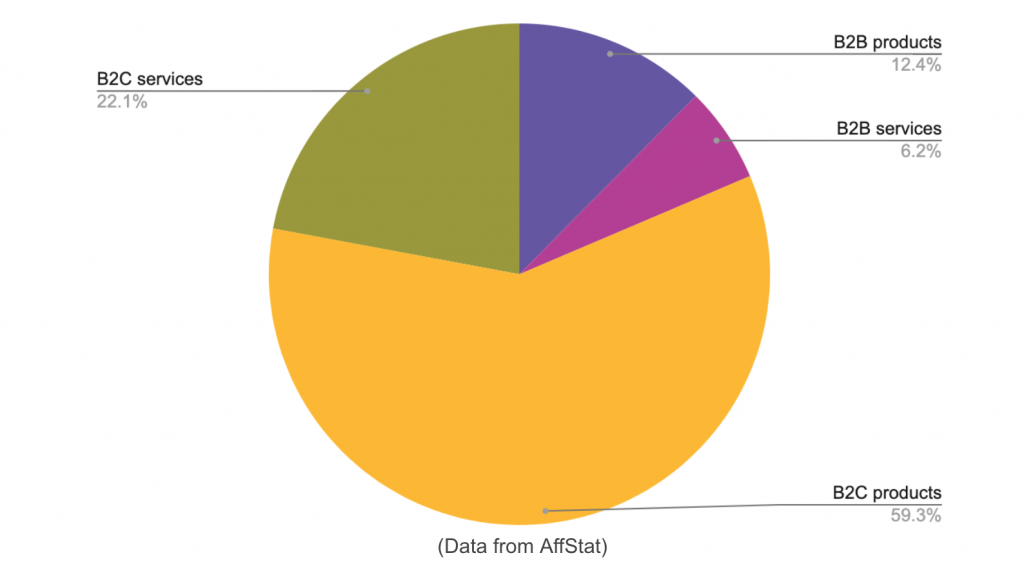Useful affiliate marketing statistics in 2022
Affiliate marketers are here to stay. Since its rapid growth in the 2010s, affiliate marketing remains one of the most popular strategies to drive sales and generate passive income. In this article, we will share some of the most exciting affiliate marketing statistics about the industry.
This post is ideal for those who want to convince others, or perhaps also themselves, of the powerful impact that affiliate marketing has on both B2C and B2B sales globally.
Here are the top affiliate marketing statistics that you will want to share with your colleagues:
1. Affiliate marketing is a multi-billion dollar industry
According to Statista, affiliate marketing spending in the U.S. alone is expected to reach $8.2 billion by 2022, more than triple what it was 10 years earlier. Globally, it was estimated in the Awin Report that advertisers invested $13 billion in affiliate marketing in 2017. These numbers, together with the consistent upward trend, demonstrate that affiliate marketers will likely continue to thrive in the 2020s and beyond.
2. 81% of advertisers and 84% of publishers in the U.S. have turned to affiliate marketing
Advertisers, or merchants, who run affiliate programs or have joined affiliate networks are able to leverage affiliate content to raise their brand awareness, encourage customer engagement, and drive more purchases. And all of this comes without the usual cost of customer acquisition.
According to a Forrester report commissioned by Rakuten, 81% of advertisers and 84% of publishers use affiliate marketing. And over half of the affiliate publishers surveyed in the same report stated that affiliate marketing accounted for more than 20% of their annual revenue.
These affiliate marketing statistics illustrate how the affiliate channel has transitioned from a coupon-dominated industry to a serious marketing channel, now used by major advertisers looking to accelerate their growth. Over 80% of them also devote more than 10% of their marketing budgets to affiliate programs.
3. Search interest in “affiliate marketing” is up over 200% since 2015
Based on Google Trends data, search interest in the query “affiliate marketing” has increased steadily over the past few years. Between 2015 and 2020, the search interest is up over 200%.
In the chart above, we see global search interest over the past 5 years. The numbers represent search interest relative to the highest point, with 100 being the peak popularity for this query.
This trend is in line with the overall rise of online shopping and the decline of brick and mortar retail. And it’s only exacerbated by the current pandemic. As people spend more time online, they’ve also started to look for alternative sources of income. This, in turn has given rise to this search trend.
4. Largest affiliate networks have 100K+ active affiliates
Many small businesses lack the financial resources to invest in online marketing effectively. That’s why the performance model provided by affiliate marketing is an invaluable tool for them to drive both brand awareness and actual sales. And there’s nothing holding larger businesses back from using it, too. Thanks to the low barrier to entry, thousands of both SMBs and larger companies rely on affiliate marketing as an additional traffic and sales channel.
But no traffic or sales would be possible without a large network of affiliate partners. A quick research on affiliate networks shows that the largest ones have at least 100K active affiliates.
The largest affiliate networks include, for example:
- Amazon Associates: 900,000+
- ShareASale: 700,000+
- Awin: 205,000+
- ClickBank: 100,000+
5. Using a price comparison website is the most common affiliate activity for web users in the UK
In their study about measuring the value of the UK affiliate market, IAB UK together with PwC concluded that using price comparison websites was the most common affiliate activity among web users in the UK during 2015–2018.
Other affiliate activities included, for example, visiting voucher code and loyalty websites or consulting expert websites and independent blogs.
6. 85% of online shoppers check Google for information before making a purchase
Consumers want to play it safe and avoid overpaying for products online. Not surprisingly, the most popular way to find more information on those items is to type a search query on Google. And this is where affiliate reviews, comparisons, and tutorials get their chance for conversion.
A Kenshoo research paper reports that 85% of online shoppers turn to Google for ideas and information before making a purchase. This makes visibility in the search results crucial for affiliate marketers. Especially considering that these users already have a high purchase intent.
7. 81.4% of affiliates promote B2C products or services
While potentially slightly outdated, the data on AffStat’s annual affiliate marketing benchmark report reveals that an overwhelming majority of affiliate marketers promote B2C offers. In fact, 81.4% of them work with affiliate programs that operate in the B2C sector. The remaining 18.6% focus their efforts on B2B products and services. There is of course some overlap, too.

The top 5 categories that affiliates promote are computer and electronics (40%), clothing/apparel (41%), online services (30%), accessories (29%), and beauty (28%). Business (25%) and marketing (20%) are not far behind, however, both ranking in the top 10 categories.
The top 3 traffic sources for these affiliate product categories include SEO (69%), social networks (67%), and blogging (64%). While SEO and blogging are obviously intertwined, it’s interesting that email marketing is only in 4th place (41%) in the survey.
8. Content and blogs generate almost 40% of affiliate publisher commissions in the U.S.
Another indication of the transition from coupon-focused affiliate marketing to a more serious marketing channel is the increased share of commissions earned by content affiliate marketers.
According to the Awin Report, content and blogger websites earned almost a 40% share of publisher commissions in the U.S. This is part of the growing diversification of affiliate channels.
9. 71% of affiliate publishers in the U.S. work with 3 or more networks
Since affiliates are all about optimization, it’s no wonder that they prefer to maximize their opportunities to work with merchants. Based on the Forrester report, 71% of U.S. affiliate publishers belong to 3 or more affiliate networks. Only 6% work just with one affiliate network.
Similarly, it was reported by AffStat that 42% of affiliates belong to 1–10 affiliate programs.
10. Largest coupon affiliate websites generate over $1 billion in revenue
We have companies whose business models are built on affiliate commissions alone. The most well-known of these is Groupon, a company that connects subscribers with local merchants. According to Statista, it has an annual revenue of about $1.4 billion and its number of active users peaked at over 50 million.
It’s worth noting, however, that Groupon and other coupon websites have recently suffered from declining revenues. The coupon model is cutting margins away from the merchants. This leads to a lower-quality customer base and also reducing the commission amounts for affiliates. It’s also vulnerable to changes in the economic cycle like we witnessed during the pandemic.
11. Organic search has a 53% traffic share on average across industries
What is especially relevant for content-focused affiliate marketers is that organic search is the channel that delivers the most traffic to websites. As reported by BrightEdge, organic search has a 53% traffic share on average across industries, whereas paid search accounts for 15%. And B2B and technology companies generate more than half of their revenue from organic search.
So, while ranking for the right keywords in the organic search is fiercely competitive, it’s still a good channel for anyone who’s willing to put in a continuous effort to publish optimized content. Choosing the right products first of all and knowing how to improve your ranking ability helps if you plan to generate affiliate sales through organic traffic.
12. 35% of affiliates make at least $20K in annual revenue from their affiliate marketing efforts
Given the strong performance-focus of affiliate marketing, this list would be incomplete without at least some revenue figures. But because affiliate marketing is such a complex channel and covers a variety of niches, it’s hard to provide any accurate data on the average affiliate marketer revenue. In the benchmark report by AffStat (The source for affiliate marketing statistics and benchmarks), 35% of the affiliates disclosed an annual revenue of at least $20,000 derived from their affiliate marketing efforts.
You might also have come across some polls on affiliate marketing forums where affiliates were asked about their annual income. But these samples are usually not large enough to make any reliable estimates. Besides, many affiliates use affiliate marketing as an extra source of income and dedicate only minimal effort on the channel. Some focus on one affiliate program only, while others promote multiple affiliate products through different programs and networks.
When looking at affiliate sales data alone, there’s little value in calculating the average commission amount. The range is simply so wide. And it also matters whether those are recurring or one-time commissions. Thanks to the subscription-based pricing model in SaaS companies, for example, the majority of affiliate commissions are recurring. This adds to the cumulative affiliate earnings.
In many affiliate programs, the smallest commissions can fall below $10. However, some affiliates can make thousands of dollars per commission. A more accurate estimate of affiliate income would require looking at the modal value (most commonly occurring) and the frequency of commissions, or total annual earnings per affiliate, as in the AffStat benchmark report.

Conclusion
All of these affiliate marketing statistics support the conclusion that affiliate marketing is a powerful channel driving value for merchants. Not only through sales but also through brand awareness. While the generated clicks and impressions can often go unrewarded, many affiliates have managed to establish a personal brand for themselves, allowing them to earn a substantial share of their income from affiliate marketing.

